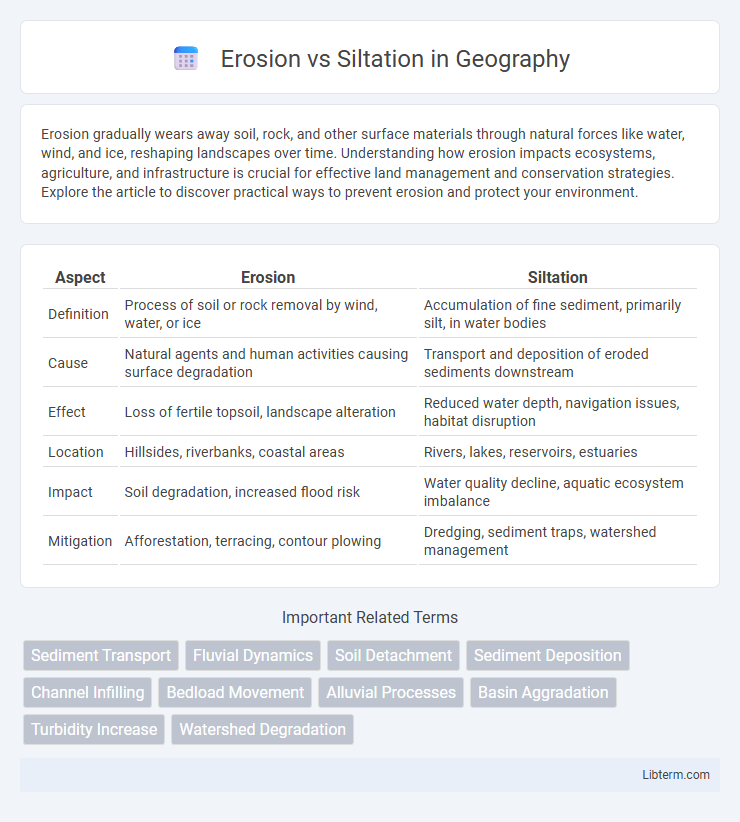Erosion gradually wears away soil, rock, and other surface materials through natural forces like water, wind, and ice, reshaping landscapes over time. Understanding how erosion impacts ecosystems, agriculture, and infrastructure is crucial for effective land management and conservation strategies. Explore the article to discover practical ways to prevent erosion and protect your environment.
Table of Comparison
| Aspect | Erosion | Siltation |
|---|---|---|
| Definition | Process of soil or rock removal by wind, water, or ice | Accumulation of fine sediment, primarily silt, in water bodies |
| Cause | Natural agents and human activities causing surface degradation | Transport and deposition of eroded sediments downstream |
| Effect | Loss of fertile topsoil, landscape alteration | Reduced water depth, navigation issues, habitat disruption |
| Location | Hillsides, riverbanks, coastal areas | Rivers, lakes, reservoirs, estuaries |
| Impact | Soil degradation, increased flood risk | Water quality decline, aquatic ecosystem imbalance |
| Mitigation | Afforestation, terracing, contour plowing | Dredging, sediment traps, watershed management |
Understanding Erosion: Definition and Causes
Erosion refers to the process by which soil, rock, or other surface material is worn away and transported by natural forces such as water, wind, or ice. Common causes include deforestation, poor agricultural practices, heavy rainfall, and construction activities that disturb the land surface. Understanding erosion involves recognizing how these factors accelerate the removal of valuable topsoil, leading to land degradation and increased sedimentation in nearby water bodies.
Siltation Explained: What It Means and How It Happens
Siltation occurs when fine soil particles, primarily silt, are transported by water and deposited in rivers, lakes, or reservoirs, leading to sediment accumulation that reduces water capacity and disrupts aquatic ecosystems. It typically results from soil erosion caused by deforestation, agriculture, urban runoff, and construction activities, which loosen soil and increase sediment load in water bodies. The process degrades water quality, harms fish habitats, and increases flood risk, making sediment control and land management essential for mitigating siltation impacts.
Key Differences Between Erosion and Siltation
Erosion involves the removal and transportation of soil or rock by wind, water, or ice, leading to land degradation and loss of fertile topsoil. Siltation refers to the accumulation of fine sediment, such as silt and clay, in water bodies, resulting in reduced water quality and disrupted aquatic ecosystems. Key differences include erosion being a source process causing sediment displacement, while siltation is a deposition process causing sediment buildup in waterways.
Natural Processes Involved in Erosion and Siltation
Erosion involves the natural processes of weathering, water flow, wind action, and gravity that remove soil and rock from the Earth's surface, transporting these materials to new locations. Siltation occurs when fine particles like silt and clay settle in water bodies, resulting from sediment carried by rivers, runoff, or coastal currents. Both processes are driven by hydrological cycles, climate patterns, and terrain characteristics, influencing landscape formation and aquatic ecosystems.
Human Activities That Accelerate Erosion and Siltation
Human activities such as deforestation, construction, and agricultural practices significantly accelerate erosion by removing vegetation cover and disturbing soil structure, leading to increased sediment runoff. Urbanization and improper land management contribute to siltation by increasing the amount of sediment transported to waterways, causing reduced water quality and disrupted aquatic habitats. Intensive farming, mining, and road development further exacerbate soil erosion and sediment deposition, escalating environmental degradation and impacting ecosystems.
Environmental Impacts of Erosion
Erosion causes the loss of fertile topsoil, leading to decreased agricultural productivity and habitat degradation. It increases sediment load in rivers, which disrupts aquatic ecosystems and reduces water quality. The removal of vegetation due to erosion intensifies land degradation and contributes to desertification in vulnerable regions.
Environmental Impacts of Siltation
Siltation significantly disrupts aquatic ecosystems by reducing water quality and depleting oxygen levels, which harms fish populations and biodiversity. It accelerates sediment accumulation in rivers and reservoirs, decreasing water storage capacity and increasing flood risks. Moreover, siltation alters natural habitats and affects agricultural productivity by smothering crops and clogging irrigation systems.
Methods for Preventing Erosion and Siltation
Vegetative cover such as grasses, shrubs, and trees stabilizes soil and reduces erosion by anchoring the soil with roots and intercepting rainfall. Engineering techniques like terracing, contour plowing, and the construction of check dams help control water flow velocity, minimizing soil displacement and sediment transport. Sediment traps and retention basins are effective in capturing silt before it reaches water bodies, preventing siltation and protecting aquatic ecosystems.
Case Studies: Erosion and Siltation Around the World
Erosion and siltation are critical environmental issues documented in case studies worldwide, such as the severe soil degradation in the Loess Plateau of China and extensive silt accumulation in the Nile Delta, Egypt. Research highlights how deforestation and poor land management accelerate erosion in the Appalachian Mountains, USA, while mangrove loss exacerbates siltation challenges in the Sundarbans, India and Bangladesh. These case studies emphasize the global impact of erosion and siltation on agriculture, water quality, and ecosystem health, urging sustainable land use and sediment control strategies.
Sustainable Solutions to Combat Erosion and Siltation
Sustainable solutions to combat erosion and siltation include implementing vegetative cover such as reforestation and cover crops to stabilize soil and reduce runoff. Engineering practices like contour terracing, check dams, and sediment basins effectively control sediment flow and prevent soil loss in vulnerable areas. Integrating community-based land management and watershed protection policies enhances long-term resilience against erosion and siltation impacts on ecosystems and agriculture.
Erosion Infographic

 libterm.com
libterm.com